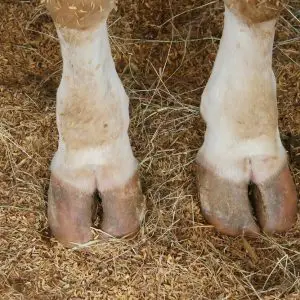Does your dog simply LOVE seafood? Does he go crazy for fishy food or treats? Or are you looking for something you can use as a high-value reward, that also has many health benefits? Prawns might be what you’re looking for!
But where do prawns come from? Are they safe for dogs? And how should they be prepared? These are all questions we will discuss, so that you can decide whether prawns are the treat for you and your dog.
Key facts
Prawns are extremely nutritious for dogs, and naturally contain high levels of protein, phosphorus, iodine, antioxidants, B-vitamins and omega oils.
Prawns can benefit your dog’s brain health, thyroid health, skin health and joint health when fed in moderation. They are also an excellent training treat.
It can be difficult to find ethically sourced prawns from MSC certified fisheries, and many east Asian produced prawns exploit human rights and damage the environment.
Prawns are available dried or fresh, with or without the shell, but the safest way to feed your dog prawns is with the shell off (including the head, legs and tail), and thoroughly cooked or boiled. Shells can cause blockages and gastrointestinal perforations, and raw prawns can carry harmful pathogens.
Remember to clean the area and your hands after handling shellfish, to prevent yourself from being affected by potential pathogens.
What Are Prawns for Dogs?
Prawns are harvested from all over the world. They can be farmed, caught with nets or caught via in-shore or ocean trawls. Even though farmed prawns are more sustainable in terms of avoiding depleting wild stocks and preventing ocean destruction, excessive use of chemicals and antibiotics in farmed prawns is common.
Prawns from China, Vietnam and Thailand are unfortunately poorly farmed, and are not an ethically-responsible choice when it comes to avoiding human rights abuse and minimising environmental impact. Greenpeace released a report in 2015 about dodgy prawns, and developed this infographic to help you make wise prawn buying choices:
(Source: Greenpeace)
Unfortunately, the labelling on prawn products is often relatively poor, and it is sometimes difficult to be confident about the traceability of a product. So when you buy prawns, always look for whether the manufacturer is Marine Stewardship Council (MSC) certified. This means all of their prawns have come from MSC sustainable fisheries and responsible suppliers.
Prawn treats for dogs can vary tremendously, depending on the manufacturer and processing that they have gone through. You can buy whole dried prawns with shell on, and dried prawns with the shell off. Prawns are usually dried in a commercial drying chamber, which ensures that all the nutrients are retained in the prawn.
The rationale behind dried prawns is that they can last much longer than fresh prawns, and don’t require any special cooking at home before opening the packet and giving one to your dog. Crustacean shells also contain glucosamine, which is a precursor for joint cartilage, but there are both benefits and downsides to feeding prawns with shells, which we will discuss a little bit further on.
You can also buy raw prawns which you prepare and cook yourself. If you wish to prepare your own prawn treats, it is always recommended to de-shell prawns, including head, tail and legs, and fully cook or boil them before giving them to your dog. It is not necessary to de-vein them. They can then be given as part of a meal, individually as a snack, or cut into tiny pieces for high-reward training treats.
not recommended RAW
raw feeding prawns
Some people who feed their dogs raw food advocate feeding raw whole prawns to dogs. However, while prawns provide plenty of nutrients in this natural form, they can also be very harmful. For example, the shells could perforate the gut or pathogens could make your dog ill. We would therefore discourage people from raw feeding their dogs prawns with the shell on.
Benefits of Prawns for Dogs
There are multiple health benefits which prawns provide for dogs. They help promote healthy brain function, thyroid function and joint health, as well as being a nutritious food source.
Key benefits
Joint Health
Prawns contain Omega-3 and Omega-6 fatty acids which are proven to improve joints.
Nutritious
Prawns contribute to healthy bones (including teeth) and efficiently functioning kidneys.
Prawns contain many natural compounds. They are naturally very high in iodine; a mineral which is vital for thyroid and brain health. However, balanced dog foods should contain enough iodine for your dog if he has no problems, so in this instance, additional iodine does not make a difference. But if your dog has an underactive thyroid, he may benefit from prawns being added to his daily diet.
Omega-3 & Omega-6
They are also very high in omega-3 and omega-6, which are also known as omega oils or fatty acids. These fatty acids are natural compounds which have been scientifically proven to produce anti-inflammatory effects, which is ideal for dogs with skin allergies or joint disease. They also enhance skin and joint health by improving the skin barrier’s defences to environmental substrates, and improving joints by making the joint fluid more viscous, thereby enhancing the joint’s ability to glide smoothly and deal with concussive forces.
Nutritional Information (Dried*)
*Fresh prawns have a significantly higher moisture content, and therefore the nutrients are much less concentrated than dried prawns.
Nutrition
Prawns are high in protein, B-vitamins and phosphorus. This is good because a dog’s diet should be made up of a large percentage of protein, which is beneficial for muscle growth and synthesis of DNA. B-vitamins also have an impact on cell metabolism, brain function and energy levels, and phosphorus contributes to healthy bones, including teeth, and efficiently functioning kidneys.
Selenium & Astaxanthin Antioxidants
Prawns are also a great source of selenium and astaxanthin antioxidants. Antioxidants fight free radicals which can be damaging to the body, and as a result improve your dog’s immunity. They can even reduce the likelihood of developing certain types of cancer.
The calorific content of prawns has not been established, however, they are very low in carbohydrates, meaning they are also low in calories. In addition to this, they are low in fat, so they are suitable for dogs watching their waistline. However, for a low calorie, low fat treat, they are still relatively high in cholesterol, so should only be given in moderation.
The calorific content of prawns has not been established, however, they are very low in carbohydrates, meaning they are also low in calories. In addition to this, they are low in fat, so they are suitable for dogs watching their waistline. However, for a low calorie, low fat treat, they are still relatively high in cholesterol, so should only be given in moderation.
Feeding Guide
There is no set quantity of prawns that a dog should or shouldn’t have in a day, and stating a number of prawns would be unreliable, since a king size prawn is tens of times bigger than a standard small prawn. There will also be a large variation between how many prawns a small breed dog should have versus a large breed dog.
In addition to this, dried prawns are significantly more nutrient-dense than raw or cooked prawns, which still contain a lot of moisture, and therefore should be more moderated than others. In other words, the larger the prawn, the more dried it is, and the smaller your dog, the less prawns you should feed.
However, as a general guide, a dog’s diet should be made up of at least 90% nutritionally-balanced commercial dog food. Therefore, the remaining 10% or less can either be made up of further dog food or healthy treats. Since prawns are relatively healthy, you can give them to your dog daily (if your wallet allows!) but as we’ve repeatedly advised, they should only be given in moderation.
Disadvantages & Risks of Prawns for Dogs
Beware the Shells!
While this may be contentious with some folk in the raw feeding community, we believe that shells pose an unnecessary risk to dogs and do not recommend feeding prawns “shell on”.
Prawns do come with quite a few inherent risks, and therefore you should be vigilant when feeding them to your dog.
Even though they can be bought both fresh and dried with shells on, this does not mean the shells are safe. The shells do provide a great source of glucosamine, but you can also provide your dog with glucosamine through feeding joint supplements or grinding up the shells of the prawns. Crustacean shells are notoriously indigestible, hard and sharp. This mean they can be traumatic to your dog’s guts if they swallow fragments of them, and potentially cause perforations. They can also cause a blockage, however it’s uncommon for your dog to swallow a piece big enough to for this to be the result.
In addition to this, all types of shellfish can pose a health risk for infectious diseases. Raw prawns can carry many different types of pathogens which can cause your dog to have a nasty bout of vomiting and diarrhoea. These can only be killed off via a thorough cooking process. As a result, you should be cautious with both raw and dried prawns. Farmed prawns are less likely to carry pathogens than wild prawns, as they are treated with chemicals and antibiotics frequently. However, this also poses environmental concerns and health concerns for your dog.
Finally, since they are usually a novel protein for dogs, dogs don’t tend to suffer from shellfish allergies; but humans can. We can also be affected by the pathogens that affect our dogs, so prawns can pose a risk to us owners too. Therefore, remember to never touch shellfish if you think you have an allergy to them, and always prepare prawns in a hygienic environment. This includes cleaning up the area your dog ate the prawns in too, and remember to wash your hands.
Prawns for Puppies

Prawns can be given to puppies, and make great high-reward training treats when cut up into very small pieces. However, puppies are still developing their natural immunity, and have very sensitive guts, so raw or dried prawns should be avoided.
Puppies can be fed fresh prawns which have been thoroughly cooked, with the shells removed. This way they are soft, and won’t damage their delicate mouths. Also, any pathogens which could cause digestive upsets will have been killed off in the cooking process.
Alternatives to Prawns
If you like the sound of prawns, but are not quite sold on them, why not try one of these alternatives?
- Sprats – Sprats are tiny fish which have been air-dried. They provide high-reward fishy treats which dogs can simply not resist. They are completely natural, and most are sourced from MSC certified fisheries in the Baltic Sea. Like prawns, they are high in omega oils, and are excellent for joint, skin and brain health.
- Fish skins – Fish skins can come in a variety of forms. They are usually dried into jerky, strips or squashed into cubes. They can be crunchy to chew through, and therefore in addition to the high omega oils and associated benefits which most seafood based products have, they are also great for dental care.
- Chicken feet – Chicken feet are a natural treat which contains lots of cartilage. Like the shells of prawns contain glucosamine, the cartilage of chicken feet contains glucosamine and chondroitin. Therefore, if you are looking for an alternative treat which benefits your dog’s joints, chicken feet may be an option. They can be fed raw, dried or puffed.
FAQs
There are multiple health benefits which prawns provide for dogs. They help promote healthy brain function, thyroid function and joint health, as well as being a nutritious food source.
Feeding prawns to dogs does carry a few risks. The brittle shells have the potential to cause trauma to your dog’s intestines. And raw prawns can carry pathogens that are harmful to your dog. The safest way to feed prawns to dogs is cooked and shell-off.
Due to the huge variance in the sizes of prawns (as well as whether they are fresh or dried) it’s not possible to say how many prawns a dog can have. However, in moderation, they can be fed daily. Vets recommend no more than 10% of a dog’s diet is made up of treats and snacks.
As with all seafood, prawns have a distinct fishy smell. This is more concentrated when they are dried, versus when they are fresh or cooked. But regardless of the type of prawns you offer your dog, you won’t be able to escape the smell.
The good news is that they smell doesn’t hang around for long, because neither will the prawns! One or two chomps (or maybe even no chomps if you’ve cut them up into training treats!) and they’re gone. Therefore your house will only smell like a fishery for a short period of time.
Prawns can cause diarrhoea in dogs if they are contaminated with bacteria or parasites. This can vary from a mild, transient infection, to serious dysentery which requires veterinary attention.
They are unlikely to cause diarrhoea in any other way, however if your dog has not had prawns before, feed only one or two at first, and watch for a reaction over the next day before feeding more. Some dogs with sensitive guts develop diarrhoea when they first try a a new food, so it is always best to introduce new foods slowly.
Prawn meat is highly digestible and soft, however prawn shells, legs, heads and tails are difficult to digest, and can cause blockages or digestive tract damage when fed. While it is uncommon for a blockage to form, as the pieces are usually too small, it can happen. Therefore it is safer to feed dogs prawns without shells.
Prawns are harvested in many different ways. They can be caught via ocean or inshore trawling, small nets, or produced in a farmed manner. Prawns which can be traced back to MSC certified fisheries have the best standards, and eastern Asian prawns should be avoided.









